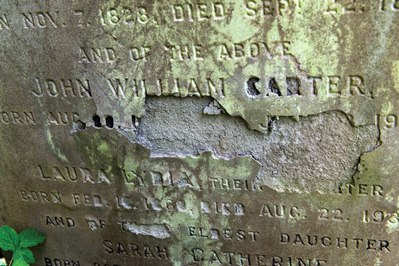Geologist and science writer Nina Morgan has stumbled across a curious case of research resurrection.
Picture: Weathering in a Pennant Sandstone gravestone erected in 1876 in Holywell Cemetery, Oxford. Photo: Mike Tomlinson.
 Visitors to Wytham Woods near Oxford may be startled to come across a group of standard-issue war-grave headstones standing in middle of a field. However, rather than commemorating the ‘Glorious Dead’, this 'cemetery' forms the basis of an experiment in rock weathering. The headstones, made of Upper Jurassic Portland limestone, carry no inscriptions and were surplus to the requirements of the War Graves Commission. Now equipped with sophisticated monitoring devices they are being used in project run by the School of Geography and the Environment at Oxford University to study stone decay, a topic of vital interest in the conservation and building stone industry.
Visitors to Wytham Woods near Oxford may be startled to come across a group of standard-issue war-grave headstones standing in middle of a field. However, rather than commemorating the ‘Glorious Dead’, this 'cemetery' forms the basis of an experiment in rock weathering. The headstones, made of Upper Jurassic Portland limestone, carry no inscriptions and were surplus to the requirements of the War Graves Commission. Now equipped with sophisticated monitoring devices they are being used in project run by the School of Geography and the Environment at Oxford University to study stone decay, a topic of vital interest in the conservation and building stone industry.
Geikie
The Oxford study – one of several investigations that take advantage of gravestones to study weathering in building stones – draws on a methodology first proposed in the 1880s by geologist Archibald Geikie (1835 - 1924). Geikie, son of a musician and music critic, began his geological career in 1885 as a surveyor in the Scottish branch of the Geological Survey. In 1860 he went on to work with Roderick Murchison (1792 - 1871), then Director of the Geological Survey, on a geological reconnaissance of the north-west highlands of Scotland.
Geikie eventually rose through the ranks to become Director General of the Geological Survey of Great Britain himself, in 1882 - until his retirement in 1901. In 1913, he moved to Haslemere, Surrey where he served as Chairman of the Haslemere Educational Museum from 1914 until his death in 1924.
Carboniferous
During his lifetime Geikie was recognised in geological circles for his studies of the Carboniferous and Permian volcanic rocks of Scotland. However, to the public at large he was perhaps best known for his readable and popular books about geology. A review of the second edition of his Scenery of Scotland, which appeared in The Spectator in 1888, praised his writing skills above his scientific talent:
"Dr Geikie is perhaps the most agreeable writer on geology now left to us. When his Scenery of Scotland originally appeared, in 1865, it had a distinct success, less perhaps in virtue of the scientific theory it expressed and exemplified, than of its picturesque descriptions, in which the ring of the geologist's hammer had the accent of poetry, somewhat perhaps as the drone of the bagpipe is positively musical when heard a sufficient number of miles off."
But along with the scenery, Geikie also described a simple method for monitoring and studying weathering in building stones, noting, in Chapter 2:
"Nowhere can the nature of weathering be more conveniently and instructively studied than upon ancient masonry, and notably among the gravestones of a churchyard. Originally as they left the hands of the mason, the stones of a wall or slabs and pillars of a monument were smoothly dressed, or even polished. We can, therefore, compare their present with their original condition, and mark the nature and amount of the disintegration they have suffered. Moreover, when the dates of their erection are preserved, we obtain from them a measure of the rate of waste."
Unlike many good ideas, this one hasn't died a death. In technology terms, its ‘operating system’ has simply been updated!
Acknowledgement
Sources for this vignette include 1885 edition of The Scenery of Scotland by Archibald Geikie available for download at https://archive.org/details/sceneryscotland01geikgoog; A leaflet about Geikie downloadable from www.haslemeremuseum.co.uk; Conservation of Historic Graveyards, a guide for practitioners, published by Historic Scotland (ISBN 1 900168 74 X); and the Dictionary of National Biography entry for Sir Archibald Geikie by David Oldroyd. For information about the gravestone weathering projects carried out by a number of research groups in the UK see: http://www.scottishgraveyards.org.uk/resources9.shtml.
* Nina Morgan is a geologist and science writer based near Oxford. Her latest book, The Geology of Oxford Gravestones, is available via www.gravestonegeology.uk. A review will appear next month.